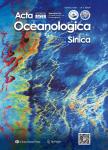Geographical distribution and age composition of Euphausia superba larvae (Crustacea: Euphausiacea) in the South Shetland Islands region and southern Scotia Sea in relation to environmental conditions
Geographical distribution and age composition of Euphausia superba larvae (Crustacea: Euphausiacea) in the South Shetland Islands region and southern Scotia Sea in relation to environmental conditions作者机构:Key and Open Laboratory of Marine and Estuarine FisheriesMinistry of AgricultureEast China Sea Fisheries Research InstituteChinese Academy of Fishery Sciences
出 版 物:《Acta Oceanologica Sinica》 (海洋学报(英文版))
年 卷 期:2013年第32卷第11期
页 面:59-67页
核心收录:
学科分类:0710[理学-生物学] 07[理学] 0908[农学-水产] 0707[理学-海洋科学] 0713[理学-生态学]
基 金:Project on the exploration of fishery resources in the offshore supported by the Ministry of Agriculture(2010-2013) Chinese Polar Environment Comprehensive Investigation and Assessment Programes under contract No.CHINARE2012~2016-01-06
主 题:Southern Ocean Euphausia superba larvae distribution pattern
摘 要:Spatial distribution patterns of the different life stages of Euphausia superba in the region of the South Shet- land Islands and southern Scotia Sea (Antarctica) were assessed based on scientific survey data collected in lanuary and February of 2010. Adults, eggs, nauplii, metanauplii, calyptopis I-Ill, and furcilia I-II were found in the investigation. The abundance of larvae averaged 1 172.8 ind./mz, with calyptopis I and II as the dominant stages. Habitat occupancy patterns varied among Euphausia superba at different stages, and three sub-regions were identified by cluster analysis. The degree of larval development increased from west to east. Larvae were not observed north of the South Shetland Islands. Calyptopis I was predominant in the water between Elephant Island and the South Orkney Islands, which featured no thermocline. Older stages, including calyptopis II and III and furcilia I and II, were common in north and northeast of the South Orkney Islands, which were characterized by high temperature and high chlorophyll concentration. Distri- bution and abundance of the early life stages of E. superba were associated with specific environmental con- ditions. According to Biota-Environment matching (BIOENV), the distributions of E. superba larvae were correlated with a combination of temperature at the surface and 200 m, and 0-100 m integrated chlorophyll a concentration.



